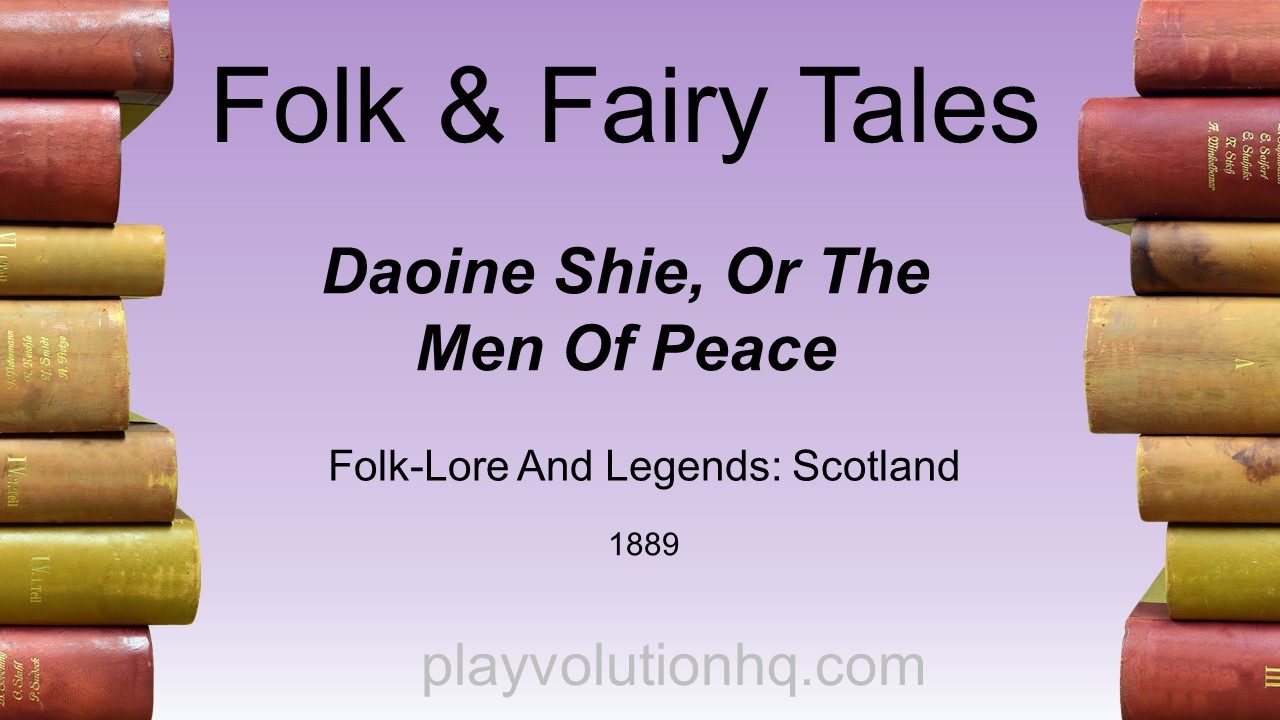
From: Folk-Lore And Legends: Scotland
Author/Editor: Charles John Tibbitts
Publisher By: W. W. Gibbings, London, 1889
Note: This story is of its time and should be read with that in mind
They are, though not absolutely malevolent, believed to be a peevish, repining, and envious race, who enjoy, in the subterranean recesses, a kind of shadowy splendour. The Highlanders are at all times unwilling to speak of them, but especially on Friday, when their influence is supposed to be particularly extensive. As they are supposed to be invisibly present, they are at all times to be spoken of with respect. The fairies of Scotland are represented as a diminutive race of beings, of a mixed or rather dubious nature, capricious in their dispositions, and mischievous in their resentment. They inhabit the interior of green hills, chiefly those of a conical form, in Gaelic termed Sighan, on which they lead their dances by moonlight, impressing upon the surface the marks of circles, which sometimes appear yellow and blasted, sometimes of a deep green hue, and within which it is dangerous to sleep, or to be found after sunset. The removal of those large portions of turf, which thunderbolts sometimes scoop out of the ground with singular regularity, is also ascribed to their agency. Cattle which are suddenly seized with the cramp, or some similar disorder, are said to be elf-shot, and the approved cure is to chafe the parts affected with a blue bonnet, which, it may be readily believed, often restores the circulation. The triangular flints frequently found in Scotland, with which the ancient inhabitants probably barbed their shafts, are supposed to be the weapons of fairy resentment, and are termed elf arrowheads. The rude brazen battle-axes of the ancients, commonly called “celts,” are also ascribed to their manufacture. But, like the Gothic duergar, their skill is not confined to the fabrication of arms; for they are heard sedulously hammering in linns, precipices, and rocky or cavernous situations, where, like the dwarfs of the mines mentioned by George Agricola, they busy themselves in imitating the actions and the various employments of men. The Brook of Beaumont, for example, which passes in its course by numerous linns and caverns, is notorious for being haunted by the fairies; and the perforated and rounded stones which are formed by trituration in its channels are termed by the vulgar fairy cups and dishes. A beautiful reason is assigned by Fletcher for the fays frequenting streams and fountains. He tells us of
“A virtuous well, about whose flowery banks
The nimble-footed fairies dance their rounds
By the pale moonshine, dipping oftentimes
Their stolen children, so to make them free
From dying flesh and dull mortality.”
It is sometimes accounted unlucky to pass such places without performing some ceremony to avert the displeasure of the elves. There is upon the top of Minchmuir, a mountain in Peeblesshire, a spring called the Cheese Well, because, anciently, those who passed that way were wont to throw into it a piece of cheese as an offering to the fairies, to whom it was consecrated.
Like the feld elfen of the Saxons, the usual dress of the fairies is green; though, on the moors, they have been sometimes observed in heath-brown, or in weeds dyed with the stone-raw or lichen. They often ride in invisible procession, when their presence is discovered by the shrill ringing of their bridles. On these occasions they sometimes borrow mortal steeds, and when such are found at morning, panting and fatigued in their stalls, with their manes and tails dishevelled and entangled, the grooms, I presume, often find this a convenient excuse for their situation, as the common belief of the elves quaffing the choicest liquors in the cellars of the rich might occasionally cloak the delinquencies of an unfaithful butler.
The fairies, besides their equestrian processions, are addicted, it would seem, to the pleasures of the chase. A young sailor, travelling by night from Douglas, in the Isle of Man, to visit his sister residing in Kirk Merlugh, heard a noise of horses, the holloa of a huntsman, and the sound of a horn. Immediately afterwards, thirteen horsemen, dressed in green, and gallantly mounted, swept past him. Jack was so much delighted with the sport that he followed them, and enjoyed the sound of the horn for some miles, and it was not till he arrived at his sister’s house that he learned the danger which he had incurred. I must not omit to mention that these little personages are expert jockeys, and scorn to ride the little Manx ponies, though apparently well suited to their size. The exercise, therefore, falls heavily upon the English and Irish horses brought into the Isle of Man. Mr. Waldron was assured by a gentleman of Ballafletcher that he had lost three or four capital hunters by these nocturnal excursions. From the same author we learn that the fairies sometimes take more legitimate modes of procuring horses. A person of the utmost integrity informed him that, having occasion to sell a horse, he was accosted among the mountains by a little gentleman plainly dressed, who priced his horse, cheapened him, and, after some chaffering, finally purchased him. No sooner had the buyer mounted and paid the price than he sank through the earth, horse and man, to the astonishment and terror of the seller, who, experienced, however, no inconvenience from dealing with so extraordinary a purchaser.
Post Author
Jeff Johnson is an early learning trainer, podcaster, and author who founded Explorations Early Learning, Playvolution HQ, and Play Haven.

Leave a Reply